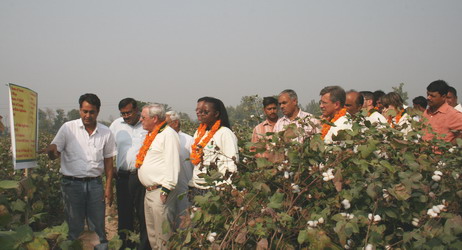
Bt Cotton's Positive Impact in North India
October 26, 2007| |
Small farmers in North India are benefiting largely from the cultivation of Bt cotton. Dr. D. Monga, Director of the Central Institute for Cotton Research Regional Station in Sirsa, Haryana State said that cotton species G. hirsutum and G. arboreum have been cultivated in India, but a decline occurred in the mid- to late 1990's due to the infestation of bollworms, significantly affecting the cotton growing farming community. The introduction of Bt cotton was instrumental in significantly raising farm income of these communities in North India. From 2005 to 2007, a total of 32 Bt cotton varieties have been successfully introduced which increased the Bt cotton hectarage from 60,000 ha in 2005 to 700,000 ha in 2007. There was a reduction in pesticide spraying of 2 to 5 times per season, a yield increase of 115-325 kg/ha and an increase in farmers income of 8,246 rupees per ha (or more than US$200).
The Center in collaboration with other national research institutions are still determined to further improve the GM cotton in the area by developing new cotton varieties that can be easily harvested through picking, with increased insect and disease resistance, and improved lint quality. Dr. Monga and his colleagues briefed Dr. Clive James and the ISAAA board members who visited CICR Regional station and interacted with Bt cotton farmers in Sirsa region.

For details contact Bhagirath Choudhary of ISAAA South Asia Office at: b.choudhary@isaaa.org
| |
Biotech Updates is a weekly newsletter of ISAAA, a not-for-profit organization. It is distributed for free to over 22,000 subscribers worldwide to inform them about the key developments in biosciences, especially in biotechnology. Your support will help us in our mission to feed the world with knowledge. You can help by donating as little as $10.
-
See more articles:
-
News from Around the World
- New WB Report Discusses Importance of Agriculture for Development
- Poverty in Developing World is Declining
- How Will Science and Technology Feed the World in 2025?
- Cassava Breeders Unite to Derail CBSD Spread
- West Africa to Benefit Much from Bt Crops, Study Says
- Africa's Fight Against Hunger Making Slow Progress
- Syngenta Licenses Chromatin’s Gene Stacking Technology
- OSU Recommends Bt Maize to Stop Spread of Corn Rootworm and Variant
- USDA Releases New Pecan Variety
- Bt Cotton's Positive Impact in North India
- Monsanto Allowed to Extend Bollgard Planting in Australia
- Monsanto and India's TNAU to Develop PRSV-resistant Papaya
- Syngenta and QUT Start Research on Producing Ethanol from Biomass
- French Think GMO Cultivation Will Help Farmers
- EU Approves Herculex RW Corn
-
Research Highlights
- Identification of a Phytotoxic Amino Acid from Fescue Grasses
- RNAi useful in Wheat Functional Gene Analysis
- GM Mulberry with Increased Salinity and Water Stress Tolerance
- Tobacco with Reduced Nornicotine by Targeted Mutation
-
Announcements
- Agri-Biotech and Biosafety Conference in Central Asia
- Vavilov-Frankel Fellowships for 2008
- International Symposium on In Vitro Culture and Hort Breeding
- Repeat Announcement: BioMalaysia 2007 – Innovation for Quality of Life
-
Read the latest: - Biotech Updates (December 3, 2025)
- Gene Editing Supplement (November 26, 2025)
- Gene Drive Supplement (February 22, 2023)
-
Subscribe to BU: - Share
- Tweet
